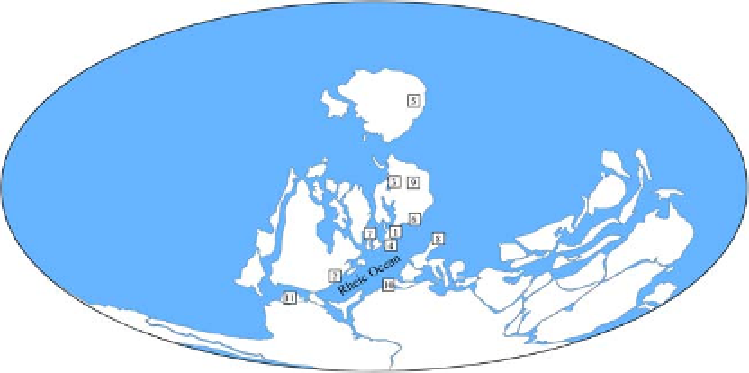Geoscience Reference
In-Depth Information
Fig. 5. Distribution of main occurrences of Lignophytes. Palaeogeographical reconstruction for the Middle Devonian
redrawn from Scotese (2003). 1, Germany (Late Eifelian to early Givetian: Kr¨usel & Weyland 1923, 1926, 1929, 1932,
1938; Mustafa 1975; Schweitzer & Matten 1982). 2, New York, USA (Late Eifelian to Frasnian: Bonamo 1977;
Dannenhoffer & Bonamo 1989, 2003; Dannenhoffer et al. 2007). 3, Russia (possibly Givetian: Iurina 1988). 4, Belgium
(Latest Eifelian to Givetian: Stockmans 1968; Leclercq & Bonamo 1971; Lessuise & Fairon-Demaret 1980). 5, Siberia
(possibly Givetian: Iurina 1988). 6, Ukrainia (possibly Late Givetian: Iurina 1988). 7, Scotland (Middle Devonian:
Dawson 1871, 1878; Lang 1926). 8, Czech Republic (Early Givetian: Krejci 1880; Kr¨usel & Weyland 1933). 9, Russia
(possibly Givetian: Iurina 1988). 10, Morocco (possibly Late Emsian). 11, Venezuela (possibly Late Givetian/Early
Frasnian: Hammond & Berry 2005).
Rellimia thomsonii (Leclercq & Bonamo 1971) and
Tetraxylopteris schmidtii (Bonamo & Banks, 1967).
Until now, the species has not been discovered
in situ in any other plant. Rhabdosporites langii is
known from localities distributed worldwide and,
in Gondwana, it has been identified in Middle/
early Late Devonian strata from Algeria, Iran,
Libya, Morocco, Tunisia and Saudi Arabia (P.
Breuer, pers. comm., 2008). Those various occur-
rences suggest that Aneurophytales were probably
widespread on the Gondwana even although macro-
fossil evidence is poor.
Accumulating evidence suggests that Gondwana
might be seen as 'the place where everything
started', at least from the botanical point of view.
The earliest known cryptospores are described
from Saudi Arabia (northern Gondwana; Lower
Middle Ordovician; Strother et al. 1996). The ear-
liest unequivocal terrestrial plant sporangia come
from Oman (northern Gondwana) and are con-
sidered to be Late Ordovician in age (Wellman
et al. 2003). The earliest occurrence of trilete spores
is around the Caradoc/Ashgill boundary in Saudi
Arabia (Steemans et al. 2009). As a result, Gond-
wana is today generally considered as the probable
centre of origin of land plants (during the Ordovi-
cian) (Steemans et al. 2010). On the basis of the
early Rellimia occurrence described here, and of
the numerous occurrences of Rhabdosporites
langii, it is possible that northern Gondwana was
the centre of origin of the lignophytes during the
end of the Lower Devonian.
The palaeogeographical distribution of the
Aneurophytales is restricted to the eastern part of
Laurussia and to NW Gondwana; their absence in
China and neighbouring areas is noteworthy
(Table 2; Fig. 5). The presence of Aneurophytales
on both sides of the Rheic ocean suggests that the
latter was not large enough during Lower/Middle
Devonian times to prevent plant exchanges
between Laurussia and Gondwana. Among the
palaeogeographical hypotheses proposed for that
period, these results are best explained by the recon-
structions developed by Scotese & McKerrow
(1990) and within Scotese's PalaeoMap project
(http:// www.scotese.com/).
Localities yielding Aneurophytales have a wide
palaeolatitudinal distribution (Fig. 5). This suggests
either that those plants could have wide ecological
tolerances or that the palaeoclimatic conditions
were rather uniform or at least favourable during
the Middle Devonian. This is consistent with the
period of global warming episode (Hot House con-
ditions) proposed by Scotese et al. (1999) for the
first part of the Devonian. It could also mean that
the Laurussia constituents (Laurentia and Baltica)
and Gondwana were grouped closer to the equator
than
suggested
by
current
palaeogeographical
reconstructions.
We thank the Minist`re de l'Energie et des Mines (Rabat,
Morocco) for the issue of a working permit, permission
to export samples and logistical advice. We also thank
Mr M. Mohammed for permission to collect fossils at his

